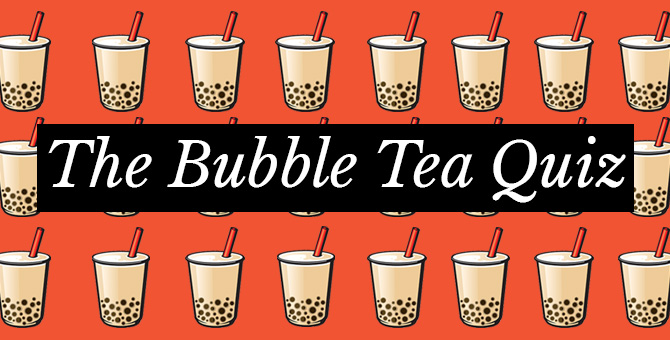Bubble tea isn’t exactly new. Depending how old you are, you’d have likely seen its evolution going from flavoured powder with questionable colouring and flavouring to today’s competitive use of fresh ingredients.
Today, KL has seen bubble tea franchises sprout up like mushrooms, with some of them gaining so much popularity that people are willing to wait 40 minute to an hour for a cup of that sweet, sweet indulgence.
The question is: How matcha do you actually know about bubble or boba tea? We’re cha-llenging you to a tea-st. No? Is that pun trying too hard? You can’t blame us for trying to milk all the tea puns we can think of. Anyway, let’s begin!
POLL: There are no right or wrong answers for this—how much do you love bubble tea?
{insert poll tpl=”sub-vote-freesize.tpl” id=”40″}
1. Which country did bubble tea first originate from?
Taiwan
Hong Kong
Japan
China
Traditionally, bubble tea is a Taiwanese drink that’s essentially made up of a freshly brewed tea mixed with milk, sugar and “QQ” (chewy) pearls. It used to be shaken with ice in a cocktail shaker.
2. When was bubble tea invented?
1970s
1980s
1990s
2000s
Yes, bubble tea now is a huge global phenomenon but it actually dates back to the 1980s. There’s no one official origins story but the most common one links it the Chun Shui Tang teahouse in Taichung, Taiwan. Its founder, Liu Han-Chieh was inspired after seeing iced coffee being served in Japan.
Then, in 1988, the teahouse’s product development manager, Lin Hsiu Hui, was bored during a staff meeting and candidly poured the tapioca pudding balls she had brought along into her Assam iced tea. It was so good—and everyone at the meeting agreed—that it wound up on the store’s menu and eventually became a bestseller.
3. Why is it called “bubble tea”?
Because of the pearls
Because of the foam on top
Because the person who invented it was nicknamed “Bubbles” Lin
Because it used to be served in a cup with a bubble dome-like cover
Lin might have been a bubbly person but no, the name “bubble tea” goes back to the traditional method of making it. Shaking the tea and milk together in the cocktail shaker would result in a bubble froth on top of the drink, and that’s how it got its name. It has also been called milk tea, pearl tea, tapioca tea, boba tea, boba nai cha, foam milk tea, momi milk tea, Q (which means “chewy” in Chinese), and many others.
4. What are the boba pearls made from?
Tapioca
Brown sugar
Taro
Yucca
Boba pearls are made from tapioca, and this tapioca is a starch that comes from cassava root. The starch is then rolled into a ball before it’s boiled or cooked. The texture is meant to be smooth and soft on the outside, and slightly chewy on the inside. It’s commonly the key ingredient to defying whether a bubble tea is amazing or not. They can’t be overcooked—or they’ll be quite mushy—and they can’t be undercooked—or they’ll be “crispy” or “hard”.
5. Why are the boba pearls black in colour?
Because of the food colouring
Because it’s coated in brown sugar
Because it changes colour when you boil them
Because it’s boiled in black tea
The boba pearls that contain just the cassava root are originally white (or translucent). The dark-coloured pearls are those combined with brown sugar to give them extra taste and that distinctive appearance.
6. What does “boba” actually mean?
Pearls
Bubbles
Big boobs
Big balls
It’s true so be careful where you use the word “boba”. In Taiwan, the word “boba” (波霸) is indeed a made up of the words “bubble” and “big” but put together, it becomes a slang for “big breasts” or “buxom lady”.
The pearls were originally smaller (about 1/12″) but then one tea shop owner decided to up his game and use larger tapioca pearls. On top of that, he used a more provocative name to distinguish the difference and obviously, to gain more attention.
7. Does bubble tea have caffeine?
What? No.
Yes, but only as little as green tea.
Yes, more than a can of Coca-Cola
This depends on which tea base you pick. Today, there’s a huge variety of bubble tea flavours but going back to the original style, that is Taiwanese-style milk tea, research has found “that bubble tea on average contains more caffeine than three-and-a-half cans of Coca-Cola”. Pregnant women, beware!
8. Is bubble tea gluten-free?
Yes
No
Because bubble tea has evolved so much, there are ways to make it a healthier drink than it traditionally is. Boba, which is made from tapioca, is technically gluten-free and so is the tea itself, so yes, it is gluten-free. However, boba doesn’t really contain any vitamins, minerals or fibre. In addition, all that empty carbohydrates might cause constipation instead.
9. Generally, a bubble tea contains the same amount of calories as…
Nasi lemak
Egg sandwich
Ais kacang
Two pieces of fried chicken
On average, a cup of bubble tea contains roughly 400 calories. Indulging in a bowl of ais kacang would actually cause you less calorie intake. To go into further detail, each tapioca ball is estimated to be around five to 14 calories. If you do the math, that’s quite a lot of calories in a cup with just the boba alone.
How well did you score? Hopefully, you learnt a little more about the drink you love. Last, but not least, there’s a strong debate on which place has the best bubble tea. Take the poll below to let us know!
VOTE: Which is your favourite boba tea place in KL?
| SHARE THE STORY | |
| Explore More |




